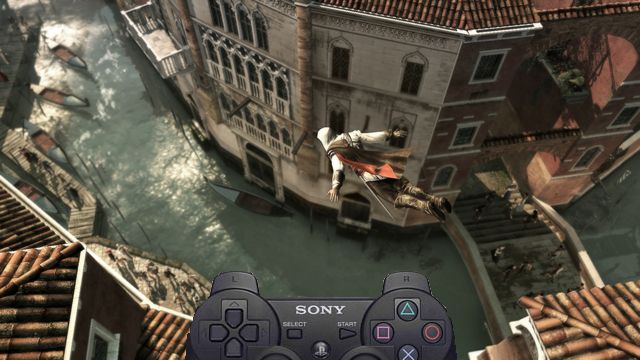Videogames are a limited medium. Those limits are what define it; the boundary between you and the screen, between your actions and the game’s perception of that input, are what separate us from those virtual worlds. This gulf has always been there, from Pong to Crysis, and even though there are games and systems of input that attempt to rebuff this, it’s something that will always exist, even when we’re replicating L.A. Noire on our specially-branded Star Trek holodecks. This boundary, while inherent to the nature of the medium, isn’t constant, of course. As the medium progresses, we see more and more examples of the gap widening and narrowing, in an almost wave-like form. Even though this gulf is so integral to the medium, it’s not always detracting, but at the same time, it’s difficult to produce any sort of meaning out of an experience so divided, so detached, due to this wide berth between the player and the game.
Another term for this concept is “immersion”. Immersion lies within the relative metaphorical length of this gap; the shorter it is, the more the player is drawn into the experience, the more they’re drawn into the role of the player character, and the more emotional attachment they have to the experience. The wider it is, the less the player has to do with the character, the less interaction they have with the role, etc. Immersion is what lets you become someone playing a part in this world, whether you’re just an avatar for yourself or a pre-defined character. One can attain immersion through gameplay choices, strategy, or just a good narrative (in much the same way as a novel). It’s what makes our choices in Dragon Age: Origins feel important, what makes our Starcraft II matches intense, and what makes us care the extensive cast of Grim Fandango.
The nature of immersion isn’t something that has come to the forefront of the medium until somewhat recently, though it’s a concept that’s always been there. It’s merely a measure of the aforementioned boundary, and it’s just as inherent. As Brendan Keogh mentions in one of his pieces for Kill Screen on the subject, “If you are playing Space Invaders, it would not be strange to answer the question ‘What are you doing?’ with ‘I am shooting aliens.’” It’s as simple as that. When you play a game, you step into that pre-defined role (even your self-made avatars are engaging in pre-defined plots, making pre-defined choices). The issue is, how well does a game do at making you feel like you truly fit into it?
Recently, I tried playing Assassin’s Creed II again. I didn’t care for it much in my first playthrough, and I was attempting to see if there was something I ended up missing along the way of that. My opinions on the game haven’t changed, but the experience opened my eyes to the nature of immersion somewhat, mostly through... the game doing a very poor job of giving me any sense of the concept. At almost every opportunity, it rebuffed any attempt to allow me to fill that role, through a myriad of ways.
Let’s start with the plot. When you’re dealing with immersion, you want to have a character you can take the role of, someone you can emphasize with, someone whose shoes you feel comfortable stepping into. In Assassin’s Creed II, you play as Desmond, a test subject using a science-fiction plot device to go through memories of his Assassin ancestors. Desmond is a decent character; he’s bland and all, but he doesn’t really stand against you. However, once you step into the Animus (the plot device) and take on other roles, things start to fall apart. In most of the game, you’re “controlling” Ezio, an ancestor of Desmond in Renaissance Italy. However, you’re not actually in control. You’re playing as Desmond who is playing as Ezio in the Animus.
This is where the rebuffing begins.
The game loves reminding you of the construct it has placed you in. You’re regularly accosted by a somewhat-intrusive interface, and there are elements of it that seem like the creators wanted to reduce the immersion. For example, if you’re doing a mission with a time limit, when the limit is halfway met, the game plays a honking tone. Normally this wouldn’t be much of an issue, but when you’re playing as a character in Renaissance Italy, hearing a tone that sounds almost exactly like someone placed a microphone next to a car horn does a lot to rip you out of the experience. Every time you finish a “sequence” (aka a chapter in the plot), the game “re-assembles” the world in the Animus, to remind you that you’re not really there.
The gameplay further enlarges the boundary. Immersive design would make you feel like you were there, like you were making important decisions, like your input really mattered. In Assassin’s Creed II, it’s generally the opposite. Most of the game is focused on “free-running” and traversal of the environments. To move around, you hold down two buttons and aim yourself around. That’s about it. The only other technique required to move around is crawling around a building until you find the right handhold that allows you to climb up it. While this does allow for easy movement, it makes the player feel insignificant. You feel as though you’re not really doing anything. You’re just pointing at places for this character to go, rather than feeling like you’re a person running around this well-realized world.
As a counter-example, let’s look at Mirror’s Edge, a game solely focused around movement and traversal. In there, you don’t just hold down a button and point; you have to think ahead, you have to think about your actions. See a small gap you have to fit through? Quick tap of the trigger, slide through. A small hump? Quick button press, vault right over. You’re constantly moving forward and making decisions, rather than just awkwardly pointing yourself around a building. As such, you feel like you have an impact. Your decisions decide whether you can progress or not, and they make it feel like you’re really running through these environments, making split-second decisions, while in Assassin’s Creed, you’re just... a person holding a controller, aiming this three-dimensional construct around.
Assassin’s Creed II has a few other elements of gameplay that add to the gulf. A lot of the game is also focused around doing repetitive missions, most of which seem arbitrary. Like when your “notoriety” (how much the law dislikes you) is high, you can lower it by killing certain officials, ripping down posters, etc. So you go and rip down four posters, and all of a sudden everyone forgets this hooded assassin is walking around. You know, like in real life.
There are other issues with the game I could rag on that reduce the immersion. The game has poor AI, the facial animation is bad, there are bugs everywhere (at least when I played it), etc. But I doubt those were wholly intentional, and as such they lend almost nothing to this discussion.
The main issue here is the fact that they designed against immersion. From the very start of the game’s main plot, you’re constantly reminded that it’s just a construct, that you’re just playing a videogame. Yes, this is intentional. That’s what makes it worse. They intentionally designed a game to be difficult to get into. They intentionally designed a game in which one cannot feel significant. They intentionally designed a game with almost no sense of immersion.
And, while one can use a lack of immersion well, this lack of immersion results in a wholly mediocre experience, at least in my view. As I’ve said before, that boundary between the player and the game will always exist. Every designer knows that. It’s not always something that always needs to be addressed either. However, when you purposely design a game with the intent of a wide gap between you and the character, in terms of narrative and gameplay, it generally doesn’t work, at least not when you’re making something game-like. (Most visual novels and linear interactive fictions are exempt from this for that reason.)
For a game that uses lack of gameplay immersion well, let’s look at Persona 3. (Yes, you knew I’d bring a JRPG into this sooner or later.) The main character of this game is a player avatar, of sorts. He’s bland and generally inconsequential, just like Desmond in Assassin’s Creed. However, you’re given something important in this game to offset that: choice. Your decisions in the game’s social links (interactions with other characters) make that bland avatar you, rather than just a boring protagonist. However, as the game moves on, those choices feel less and less “free”. Your avatar grows further and further away from you. Eventually, you’re left with someone making his own decisions and doing what he has to do as the plot entails. And, in the end, he’s his own person, in a sense. He’s not you as much as he’s something that came out of you. The immersion created out of that choice is gone, but you’re left with a person and a world that you created.
It’s not very immersive in terms of gameplay, like most JRPGs. It’s not a genre that entails it. However, that contrast between your choices and the character those choices create, a character that has to go on to make his own decisions as a construct of this world, ends up becoming very moving. You’re not really Minato/Minako by the end of that game. You don’t feel like you are them; they are separate entities. But you still care about what happens to them.
Yume Nikki is another strange example, though I think what makes it strange is the contrast between its use of certain aspects of immersion. There’s not really a narrative. You’re a little girl having dreams. That’s it. However, the game makes use of dense, heavy atmosphere to make you tense, to make you care about what’s going on. When you’re wandering through these desolate, bizarre worlds created within her mind, you’re not really making any big narrative decisions, you’re not going through deep systems of choice. Yet you still care about her and what happens to her because of the minimal gameplay and the atmosphere.
Assassin's Creed II is definitely going for a different sort of immersion than Yume Nikki or Persona 3, but... well, it's hard to say what sort of immersion it's going for, considering how it appears to purposely rebuff most elements of immersion.
Honestly, at this point I've started to believe that Assassin's Creed II is a sort of Suda 51-esque deconstruction of videogames. The whole "Animus" framing device is a commentary on the nature of immersion itself and how our daily lives are always repetitive and boring, no matter what era we live in. The bland acting and lack of intent in the writing are there on purpose, to show the lack of emotional investment one gets in a game when there's such a lack of immersion.
And, like most Suda 51 games intended to be "commentaries", it's not very fun to play.
(I'm sorry, Suda.)
Immersion is a strange concept in that there always seem to be exceptions to any generalization one could make about it. Assassin’s Creed II did a lot of things wrong in terms of the concept, making me feel insignificant in almost every way, yet there are definitely other games that have made excellent use of lack of certain elements of immersion to attain other ways of gaining investment from the player. I believe the big thing to take from this is that use of immersion is significantly important to the quality of a game, and that, at the same time, it’s difficult to attain and understand. Assassin’s Creed II is merely an example of what happens when you design a game so intent on widening the eternal boundary between player and game. As such, I don’t like it very much, but there’s definitely some interesting material in there, and I’m always thankful for new perspectives on issues like this.




